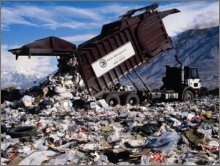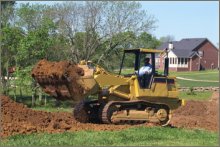How Dangerous is it Really to Live Near a Landfill? (And How Near is Too Near?)
by www.SixWise.com
The U.S. population produced more than 236 million tons of
garbage in 2003 (about 4.5 pounds of waste per person per
day, according to the U.S. Environmental Protection Agency
(EPA)). All of this waste gets put into landfills, which are
decreasing in numbers (from 8,000 in 1988 to 1,767 in 2002)
but gaining in size.
|

Landfills produce leachate, a toxic liquid squeezed
out of the garbage that contains a slew of chemicals.
|
Today's landfills are significantly bigger than they were
just two decades ago, and increasing numbers are reaching
full capacity. When a landfill is full, it gets capped and
usually planted with grass, the end result looking like a
large, grassy hill, with small chimneys to releases gasses.
A closed landfill does not look particularly threatening,
but evidence is pouring in that there's more going on than
meets the eye.
How Landfills Work
Trash is compacted into tight blocks called cells before
being deposited in the landfill. It's then covered with multiple
layers, including a thick covering of soil, at the end of
each day. Once the landfill reaches capacity, it's covered
with a plastic material, then soil and grass.
"Most U.S. landfills are called dry tombs," says
Steve Wall of the U.S. Environmental Protection Agency (EPA).
"Ideally, landfills are carefully engineered and monitored
systems that keep household garbage dry so they don't contaminate
surrounding water or air."
Safeguards are in place to keep toxins in the landfill, and
out of surrounding communities, however, "people are
concerned because trash inside lasts for generations,"
Wall says.
Landfills Leak Toxins
Landfills produce significant amounts of methane gas, along
with leachate, a toxic liquid that comes out of all that compressed
trash. Leachate is full of organic
and inorganic pollutants, including toluene, phenols,
benzene, ammonia, dioxins, polychlorinated biphenyls (PCBs),
chlorinated pesticides, heavy metals and endocrine-disrupting
chemicals.
Landfills often have pipes designed to route and collect
leachate to keep it from contaminating ground water (which
can become your tap water). However, even the best collection
systems and landfill liners inevitably deteriorate and leak,
according to the EPA:
"No liner ... can keep all liquids out of the ground
for all time. Eventually liners will either degrade, tear,
or crack and will allow liquids to migrate out of the unit.
Some have argued that liners are devices that provide a
perpetual seal against any migration from a waste management
unit. EPA has concluded that the more reasonable assumption,
based on what is known about the pressures placed on liners
over time, is that any liner will begin to leak eventually."
If and when a landfill does leak, toxins are allowed to
escape directly into the environment, where they can contaminate
air, water and soil.
Health Risks Linked to Landfills
|

If you have a choice, it's probably best to locate
your home at least two miles from a landfill.
|
Studies have shown possible increased risks of certain types
of cancer, including bladder, brain and leukemia, among people
who live near landfills.
Further, a study by researchers at the London School of Hygiene
and Tropical Medicine also found that babies born to mothers
who live near landfills have a greater risk of birth defects.
"There was a significantly overall increased risk of
neural-tube defects, malformations of the cardiac septa (hole-in-the-heart),
and malformations of the great arteries and veins in residents
near the landfill sites in our study," the researchers
said.
And, a recent study found that living near a landfill could
expose residents to chemicals that can reduce immune system
function and lead to an increased risk of infections.
As opposed to children living in clean areas, the study found
that "children living near to waste sites, whether landfills
or contaminated bodies of water, are hospitalized more frequently
with acute respiratory infections, said Dr. David O. Carpenter,
director of the Institute for Health and the Environment,
at the State University of New York at Albany. Children living
near waste sites also had increased rates of hospitalization
for asthma.
Carpenter said the extent to which toxic landfill contaminants
suppress the immune system has been "underestimated."
"While our specific study focused on air transport of
the contaminants, they are also in our food," Carpenter
said, "and the effect of exposure should not be different
whether it is via food or air. So we really need to get these
chemicals out of our environment to the greatest degree possible."
Ideally, we would all live in pristine environments, free
from pollution of all kinds. Realistically, it may be worthwhile
to avoid living near landfills, if you have a choice. If you
don't, try to stay more than two miles away, as the health
effects, at least in the birth defects study, lessened beyond
this point.
Recommended Reading
What
are the Dangers of Living Near Cell Phone Towers?
Common
& Controversial Pollutant in Drinking Water, TCE, Linked
Strongly to Cancer
Sources
Reuters
September 8, 2006
EPA:
Municipal Solid Waste
Rachel's
Democracy and Health News #848 March 30, 2006
BBC
News